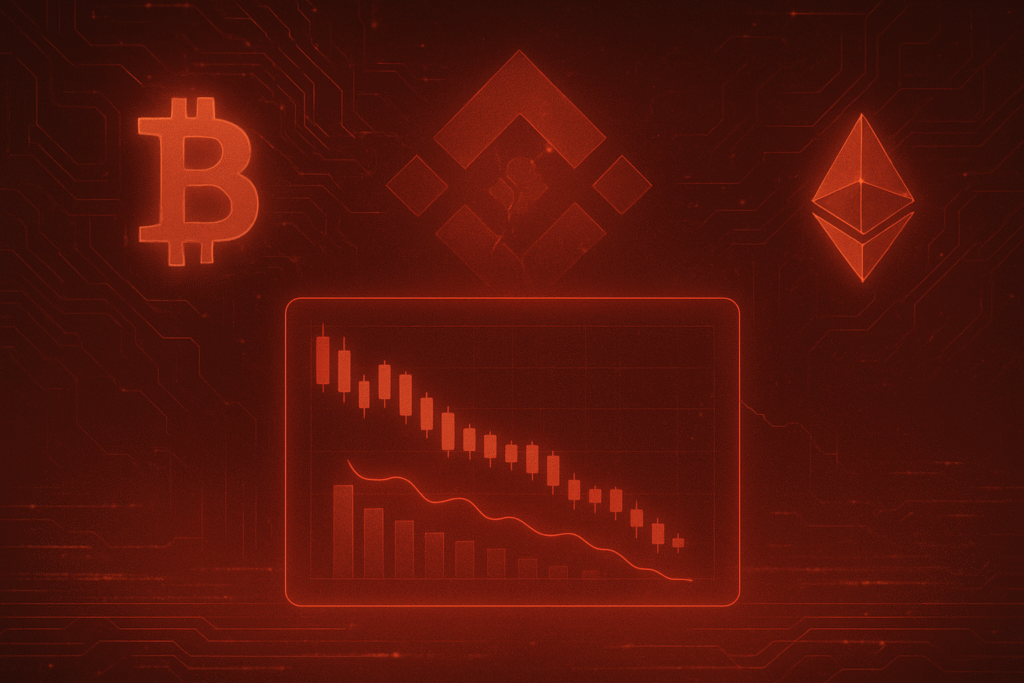
The cryptocurrency market experienced a significant downturn in September 2024, as spot trading volumes across centralized exchanges plummeted to their lowest levels since June of the same year. This substantial contraction, with total volumes ranging between $1 trillion and $1.67 trillion, signaled a noticeable cooling in retail investor enthusiasm and a broader shift in market dynamics. The immediate aftermath saw a mixed bag of reactions, with Bitcoin (BTC) surprisingly defying its historical "Redtember" curse, while altcoins largely underperformed, and the derivatives market surged.
This dramatic dip in trading activity is more than just a blip on the radar; it represents a crucial test for the market's leading players, particularly Binance (BNB:BNB), which saw its spot market share fall to levels not seen since January 2021. The decline underscores a maturing market grappling with macroeconomic uncertainties and evolving investor behavior, pushing exchanges to adapt to a landscape where institutional interest and leveraged strategies are gaining prominence over traditional spot trading. The implications ripple across the entire crypto ecosystem, impacting network revenues, DeFi protocols, and NFT markets, prompting a re-evaluation of current strategies and future outlooks.
Market Impact and Price Action
September 2024 proved to be a complex and, at times, counter-intuitive month for the cryptocurrency market. Despite a significant plunge in spot trading volumes, Bitcoin (BTC) remarkably defied its historical "Redtember" curse, exhibiting resilience and even posting gains. Opening the month around $57,317, BTC initially faced selling pressure, dipping below $54,000. However, a strong recovery ensued, pushing its price to close the month around $63,329, marking a robust 7.3% to 7.4% gain and briefly touching $66,000. This unexpected performance was largely attributed to positive inflation data and a 50-basis-point interest rate cut by the U.S. Federal Reserve, alongside China's stimulus measures.
In contrast, Ethereum (ETH) showed positive but comparatively subdued performance. Starting around $2,427, ETH experienced significant volatility, including a "Black Monday" period that saw a sharp 40% drop from a peak of approximately $3,600 down to $2,100. Despite this early turbulence and underperformance relative to Bitcoin (with the ETH/BTC pair hitting a three-and-a-half-year low), Ethereum managed to close September around $2,659, registering a gain of 3.2% to 5.22%. Altcoins, in general, underperformed relative to Bitcoin, with Solana (SOL) notably dropping by 24.4% in early September.
The overall market witnessed a sharp contraction in spot trading volumes, plummeting to $1.67 trillion, the lowest monthly figure since June 2024, or even below $1 trillion by some reports. This represented a substantial decline from the $2.44 trillion peak in March 2024. Binance (BNB:BNB) bore the brunt of this decline, with its spot trading volume dropping a staggering 22.9% to $344 billion, its lowest since November 2023. Consequently, Binance's spot market share fell to 27%, the lowest since January 2021. While on-chain liquidity, as measured by stablecoin market capitalization, increased by $3 billion in September, average daily stablecoin transfer volumes decreased, reflecting the broader slowdown. Interestingly, spot Bitcoin ETFs, after a challenging August, saw a rebound with over $1 billion in inflows, while Ethereum ETFs faced significant redemptions.
Technically, Bitcoin traded sideways in a broad range from $56,000 to $65,000 in early September, struggling under selling pressure. Key support levels were identified around $56,000 and $52,500, with resistance at $66,500. By late September, BTC was in a consolidation phase, forming an "expanding wedge" pattern. Ethereum, after its sharp drop, found key support around $2,100, with resistance around $2,800 and $3,200. ETH also fell below its 50 and 200-day moving averages, indicating bearish short-term momentum, though its RSI showed mild bullishness by mid-month. Historically, September has been challenging for crypto, with Bitcoin declining in 72.73% of past Septembers. The September 2024 rally for Bitcoin, therefore, marked a significant deviation from this "Redtember" trend, highlighting evolving market dynamics possibly driven by institutional interest and macroeconomic factors.
Community and Ecosystem Response
The significant downturn in September 2024 sparked a predictable, yet intense, reaction across the crypto community and its broader ecosystem. On platforms like Crypto Twitter and Reddit, the initial sentiment was a mix of panic and FUD (Fear, Uncertainty, Doubt), as users shared charts reflecting losses and sought explanations for the sudden market contraction. Discussions often veered into identifying culprits, ranging from macroeconomic headwinds to perceived whale manipulation, while a polarized debate emerged between those advocating to "buy the dip" and those issuing dire warnings of further declines.
The specific decline in Binance's (BNB:BNB) market share fueled extensive discussion. Community members questioned the reasons behind this erosion of dominance, speculating on regulatory pressures, the rise of new competitors like Crypto.com (CRO:CRO) and Bullish, or even internal operational shifts. While some expressed concerns about the long-term stability of centralized exchanges, others used the opportunity to advocate for greater decentralization and self-custody. Crypto influencers and thought leaders offered varied reactions, with some attempting to reassure their followers about the long-term potential of the space, emphasizing fundamental value and the "HODL" mentality, while others advised caution and strategic de-risking. The shift towards derivatives and institutional products was also a recurring theme in expert commentary, highlighting a maturing market.
The impact of the volume plunge extended deeply into related DeFi protocols, NFT projects, and Web3 applications. Decentralized Finance (DeFi) protocols experienced a notable decline in Total Value Locked (TVL) as asset prices fell, leading to concerns about potential liquidation cascades and reduced liquidity for decentralized exchanges (DEXs). The NFT market saw floor prices plummet and trading volumes decrease significantly, pushing projects to emphasize utility and community over speculative value. For Web3 applications, user engagement often waned as token incentives lost value, and startups faced increased challenges in securing funding. This period served as a stress test for the resilience of various blockchain infrastructures, with monolithic blockchains like Sui outperforming, while some Layer 2 solutions like Polygon (MATIC:MATIC) lagged, demonstrating varying levels of robustness in a contracting market.
What's Next for Crypto
The events of September 2024, marked by a significant plunge in spot trading volumes and a notable shift in Binance's (BNB:BNB) market dominance, carry profound short-term and long-term implications for the cryptocurrency market. In the immediate aftermath, while Bitcoin (BTC) demonstrated surprising resilience, the broader market showed a clear pivot towards derivatives and institutional investment products. This indicates a maturing market where sophisticated strategies are gaining ground over purely speculative retail spot trading. The rebound in spot Bitcoin ETF inflows further underscores this trend, suggesting that regulated investment vehicles will play an increasingly vital role in attracting capital.
Looking ahead, the long-term trajectory of the crypto market will be heavily influenced by the evolving regulatory landscape and continued institutional adoption. The full operationalization of the EU's MiCA (Markets in Crypto Assets) regulation in December 2024 sets a global precedent for comprehensive oversight, while potential shifts in U.S. regulatory frameworks post-2024 election could either foster or hinder innovation. The growing interest from institutions, with many planning to increase digital asset allocations in the coming years, points towards a sustained integration of crypto into traditional finance. This maturation suggests that future growth will likely be driven by utility, robust technology, and compliance, rather than solely by speculative fervor.
Several catalysts and developments bear watching. Macroeconomic factors, particularly central bank interest rate decisions, will significantly impact market liquidity, with cuts generally expected to provide a tailwind. Ongoing technological advancements, such as Ethereum's (ETH:ETH) Dencun (March 2024) and Pectra (Q2 2025) upgrades, alongside the growth of Layer 2 solutions and the tokenization of real-world assets (RWAs), promise to enhance scalability and introduce new use cases. The continued evolution of institutional products, including the expansion of spot ETFs, will further cement crypto's position in global finance. The Bitcoin Halving in April 2024 also serves as a crucial supply-side event that could influence price dynamics.
For crypto projects, the strategic imperative is clear: focus on real-world utility, strong fundamentals, and proactive regulatory compliance. Effective treasury management and diversification of exchange listings will also be crucial for navigating volatility and reducing reliance on any single platform. Investors, on the other hand, are advised to adopt a long-term perspective, employ risk management strategies like dollar-cost averaging (DCA), and diversify their portfolios. The shift towards stablecoins during uncertain periods and exploring passive income opportunities through staking or DeFi yield farming can also help preserve capital and generate returns.
Possible scenarios for the market include a gradual recovery and maturation (high likelihood), driven by institutional inflows and regulatory clarity, potentially leading to new all-time highs for Bitcoin and Ethereum by late 2025/early 2026. A scenario of increased regulatory scrutiny leading to a more centralized, compliant exchange landscape also holds medium likelihood, as evidenced by Binance's challenges. Conversely, a prolonged bear market or stagnation, while less likely given current institutional trends, remains a possibility if macroeconomic headwinds persist. An accelerated shift towards decentralized finance (DeFi) is another medium-likelihood scenario, especially if centralized entities continue to face significant issues, pushing users towards the core ethos of crypto.
Bottom Line
The September 2024 market contraction, characterized by a significant plunge in spot trading volumes and a notable shift in Binance's (BNB:BNB) market share, serves as a crucial inflection point rather than a fundamental setback for the crypto ecosystem. While retail trading activity experienced a lull, the underlying narrative points towards a maturing market, increasingly integrated with traditional finance and driven by institutional participation. Bitcoin's (BTC) unexpected resilience during this period, defying historical "Redtember" trends, underscored its growing stability and decoupling from broader altcoin volatility, influenced by favorable macroeconomic conditions.
The long-term significance of these events for crypto adoption is overwhelmingly positive. The regulatory actions against Binance, while challenging for the exchange, highlight a global push for clarity and compliance, which is a prerequisite for greater institutional trust and mainstream acceptance. The continued integration of crypto into traditional finance through instruments like spot Bitcoin and Ethereum (ETH:ETH) ETFs, alongside developments like PayPal (NASDAQ: PYPL) enabling crypto payments and Mastercard (NYSE: MA) expanding its crypto card programs, demonstrates a sustained path toward broader utility and legitimacy. This period, therefore, should be viewed as a natural phase of market evolution, weeding out purely speculative excesses and solidifying the foundations for sustainable growth.
The future of crypto appears to be one of dual narratives: relentless innovation driving real-world utility, coupled with an ongoing process of regulatory integration and institutionalization. This will likely lead to a more diversified and competitive exchange landscape, less reliant on a single dominant player, and a more resilient asset class. While short-term fluctuations will undoubtedly persist, the fundamental drivers for crypto adoption, particularly institutional engagement and the expansion of practical applications, remain robust and are being bolstered by an increasingly clearer regulatory environment.
For investors and enthusiasts, key takeaways include the importance of adopting a long-term perspective, practicing diligent risk management through strategies like dollar-cost averaging, and diversifying portfolios. Staying informed about regulatory developments, central bank monetary policies, and institutional investment flows will be paramount. Metrics such as active addresses, on-chain transaction volumes, Total Value Locked (TVL) in DeFi, and stablecoin capitalization will offer insights into network health and market liquidity. Ultimately, the September 2024 events reinforce that the crypto market is evolving into a more sophisticated and integral component of the global financial landscape.
This article is for informational purposes only and does not constitute financial or investment advice. Cryptocurrency investments carry significant risk.







